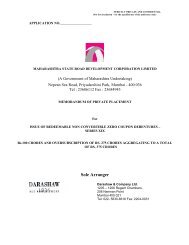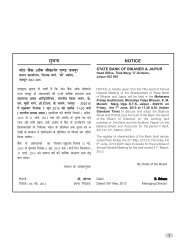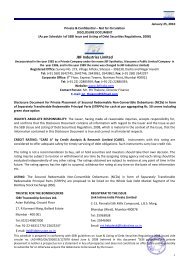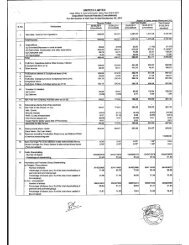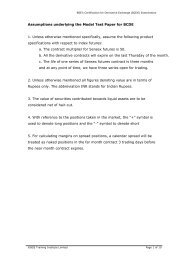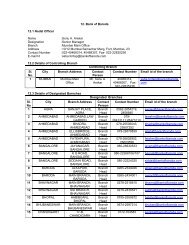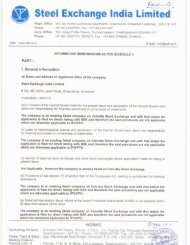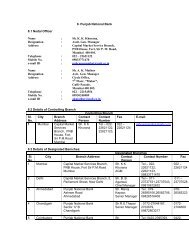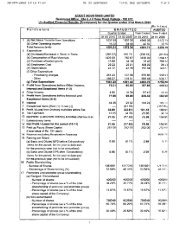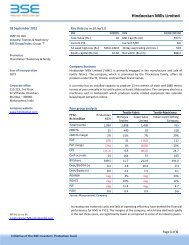JM FINANCIAL PRODUCTS LIMITED - Bombay Stock Exchange
JM FINANCIAL PRODUCTS LIMITED - Bombay Stock Exchange
JM FINANCIAL PRODUCTS LIMITED - Bombay Stock Exchange
You also want an ePaper? Increase the reach of your titles
YUMPU automatically turns print PDFs into web optimized ePapers that Google loves.
i. Foreign Currency Transactions<br />
Transactions in foreign currency are recorded at rates of exchange in force at the time the transactions are effected. At<br />
the year-end, monetary items denominated in foreign currency are reported using the closing rates of exchange.<br />
<strong>Exchange</strong> differences arising thereon and on realisation/ payment of foreign exchange are accounted in the relevant<br />
year as income or expense.<br />
j. Revenue Recognition<br />
Interest income is recognised on accrual basis except in case of non-performing assets where interest is accounted on<br />
realization. In other cases, income is recognised when there is no significant uncertainty as to determination or<br />
realization exists.<br />
k. Lease Finance<br />
Income from leased assets is accounted for in the period in which lease rentals fall due, by applying the interest rate<br />
implicit in the lease to the net investment in the lease during the period.<br />
l. Provision for Non Performing Assets (NPA) and Standard Assets (SA)<br />
All loans and other credit exposures, where the installments are overdue for a period of six months or more are<br />
classified as NPA. Provision is made in respect of NPA and SA in accordance with the stipulations of Prudential Norms<br />
prescribed in the "Non Banking Financials (Non-Deposit Accepting or holding) Companies Prudential Norms (Reserve<br />
Bank) Directions, 2007" by the Reserve Bank of India (RBI). Additional provisions (over and above the provisioning<br />
requirements under the Directions as specified by RBI) are also made as per guidelines prescribed by the Board of<br />
Directors.<br />
m. Employee Retirement Benefits<br />
(a) Post Employment Benefits and Other Long Term Benefits:<br />
Defined Contribution Plan:<br />
The Company contributes towards Provident Fund and Family Pension Fund. Liability in respect thereof is<br />
determined on the basis of contribution as required under the Statue / Rules.<br />
Defined Benefit Plans:<br />
In respect of gratuity, provision is made based upon the actuarial valuation done at the end of every quarter using<br />
“Projected unit Credit Method". Major drivers in actuarial assumption, typically, are years of services and employees<br />
compensation. Gains and losses on changes in actuarial assumption are charged to the profit and loss account.<br />
(b) Short term employee benefits:<br />
Short term employee benefits are recognized as on expense at the undiscounted amount in the profit and loss<br />
account of the year in which the related services are rendered.<br />
n. Borrowing costs<br />
Borrowing costs that are attributable to the acquisition, construction or production of qualifying assets are capitalized as<br />
a part of costs of such assets. A qualifying asset is one that necessarily takes a substantial period of time to get ready<br />
for its intended use. All other borrowing costs are charged to revenue.<br />
o. Taxes on income<br />
Tax expense comprises both current and deferred tax at the applicable enacted/ substantively enacted rates. Current<br />
tax represents the amount of income tax payable/ recoverable in respect of the taxable income/ loss for the reporting<br />
period. Deferred tax represents effect of timing differences between taxable income and accounting income for the<br />
reporting period that originate in one period and are capable of reversal in one or more subsequent periods.<br />
p. Provisions and contingencies<br />
A provision is recognized when the Company has a legal and constructive obligation as a result of a past event, for<br />
which it is probable that cash outflow will be required and a reliable estimate can be made of the amount of the<br />
obligation. A contingent liability is disclosed when the Company has a possible or present obligation where it is not<br />
probable that an outflow of resources will be required to settle it. Contingent assets are neither recognized nor<br />
disclosed.<br />
14



